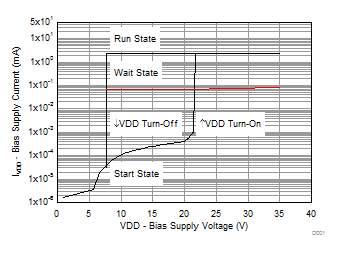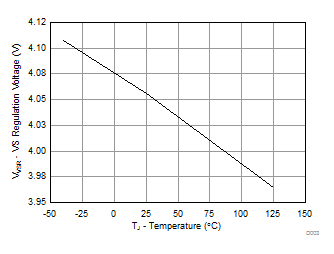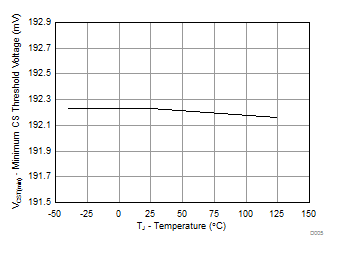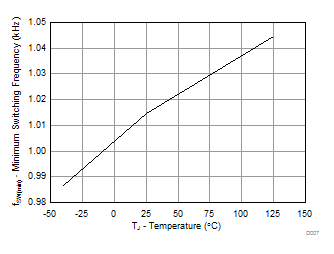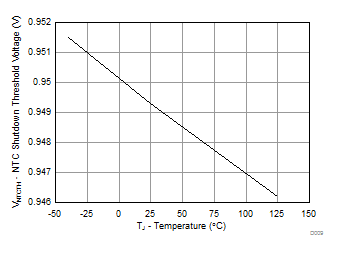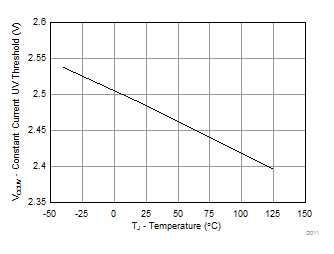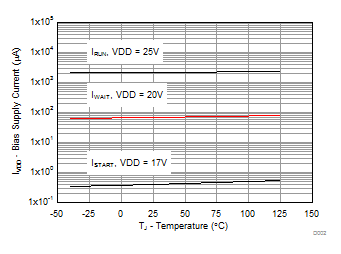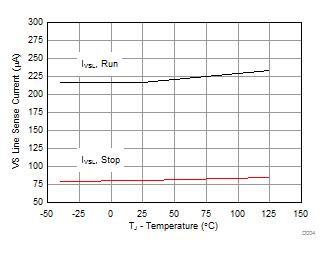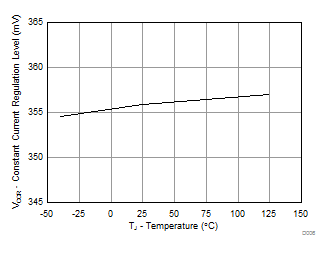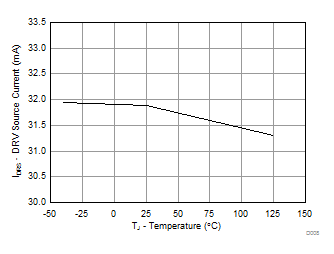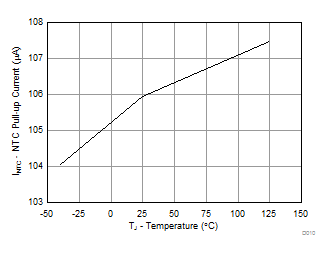ZHCSEQ1A February 2016 – February 2016 UCC28704
PRODUCTION DATA.
- 1 特性
- 2 应用
- 3 说明
- 4 修订历史记录
- 5 Pin Configuration and Functions
- 6 Specifications
-
7 Detailed Description
- 7.1 Overview
- 7.2 Functional Block Diagram
- 7.3
Feature Description
- 7.3.1 Detailed Pin Description
- 7.3.2 Primary-Side Regulation (PSR)
- 7.3.3 Primary-Side Constant Voltage (CV) Regulation
- 7.3.4 Primary-Side Constant Current (CC) Regulation
- 7.3.5 Valley-Switching and Valley-Skipping
- 7.3.6 Start-Up Operation
- 7.3.7 Fault Protection
- 7.3.8 Constant Current Under-Voltage Protection
- 7.3.9 Load Transient Response
- 7.4 Device Functional Modes
-
8 Applications and Implementation
- 8.1 Application Information
- 8.2
Typical Application
- 8.2.1 Design Requirements
- 8.2.2
Detailed Design Procedure
- 8.2.2.1 VDD Capacitance, CDD
- 8.2.2.2 VDD Start-Up Resistance, RSTR
- 8.2.2.3 Input Bulk Capacitance and Minimum Bulk Voltage
- 8.2.2.4 Transformer Turns Ratio, Inductance, Primary-Peak Current
- 8.2.2.5 Transformer Parameter Verification
- 8.2.2.6 VS Resistor Divider, Line Compensation, and NTC
- 8.2.2.7 Standby Power Estimate
- 8.2.2.8 Output Capacitance
- 8.2.2.9 Design Considerations in Using with Synchronous Rectifiers
- 8.2.3 Application Curves
- 8.3 Do's and Don'ts
- 9 Power Supply Recommendations
- 10Layout
- 11器件和文档支持
- 12机械、封装和可订购信息
6 Specifications
6.1 Absolute Maximum Ratings
Over operating free-air temperature range (unless otherwise noted) (1)| MIN | MAX | UNIT | ||
|---|---|---|---|---|
| VVDD | Bias supply voltage | 38 | V | |
| VS | Voltage range | –0.75 | 7 | V |
| CS, NTC | Voltage range | –0.5 | 5 | V |
| VDRV | Gate-drive voltage at DRV | –0.5 | Self-limiting | V |
| IDRV | DRV continuous sink current | 50 | mA | |
| IDRV | DRV peak sourcing current, VDRV = 10 V to 0 V | Self-limiting | mA | |
| IDRV | DRV peak sink current, VDRV = 0 V to 10 V | Self-limiting | mA | |
| IVS | VS, peak, 1% duty-cycle, when detecting line voltage | 1.2 | mA | |
| TJ | Operating junction temperature range | –55 | 150 | °C |
| TSTG | Storage temperature | –65 | 150 | °C |
| TLEAD | Lead temperature 0.6 mm from case for 10 seconds | 260 | °C | |
(1) Stresses beyond those listed under Absolute Maximum Ratings may cause permanent damage to the device. These are stress ratings only, which do not imply functional operation of the device at these or any other conditions beyond those indicated under Recommended Operating Conditions. Exposure to absolute-maximum-rated conditions for extended periods may affect device reliability.
6.2 ESD Ratings
| VALUE | UNIT | |||
|---|---|---|---|---|
| V(ESD) | Electrostatic discharge | Human-body model (HBM), per ANSI/ESDA/JEDEC JS-001(1) | ±2000 | V |
| V(ESD) | Electrostatic discharge | Charged-device model (CDM) ESD stress voltage(2) | ±500 | V |
(1) JEDEC document JEP155 states that 500-V HBM allows safe manufacturing with a standard ESD control process.
(2) JEDEC document JEP157 states that 250-V CDM allows safe manufacturing with a standard ESD control process.
6.3 Recommended Operating Conditions
Over operating free-air temperature range (unless otherwise noted)| MIN | MAX | UNIT | ||
|---|---|---|---|---|
| VDD | Bias supply operating voltage | 8.5 | 35 | V |
| CDD | VDD bypass capacitor | 0.047 | no limit | µF |
| IVS | VS pin sourcing current when detecting line voltage | 1.0 | mA | |
| TJ | Operating junction temperature | –40 | 125 | °C |
6.4 Thermal Information
| THERMAL METRIC | UCC28704 | UNIT | |
|---|---|---|---|
| DBV | |||
| 6 PINS | |||
| θJA | Junction-to-ambient thermal resistance (1) | 150 | °C/W |
| θJCtop | Junction-to-case (top) thermal resistance (2) | 55 | °C/W |
| θJB | Junction-to-board thermal resistance (3) | 60 | °C/W |
| ψJT | Junction-to-top characterization parameter (4) | 3 | °C/W |
| ψJB | Junction-to-board characterization parameter (5) | 55 | °C/W |
(1) The junction-to-ambient thermal resistance under natural convection is obtained in a simulation on a JEDEC-standard, high-K board, as specified in JESD51-7, in an environment described in JESD51-2a.
(2) The junction-to-case (top) thermal resistance is obtained by simulating a cold plate test on the package top. No specific JEDEC-standard test exists, but a close description can be found in the ANSI SEMI standard G30-88.
(3) The junction-to-board thermal resistance is obtained by simulating in an environment with a ring cold plate fixture to control the PCB temperature, as described in JESD51-8.
(4) The junction-to-top characterization parameter, ψJT, estimates the junction temperature of a device in a real system and is extracted from the simulation data obtaining θJA, using a procedure described in JESD51-2a (sections 6 and 7).
(5) The junction-to-board characterization parameter, ψJB, estimates the junction temperature of a device in a real system and is extracted from the simulation data obtaining θJA, using a procedure described in JESD51-2a (sections 6 and 7).
6.5 Electrical Characteristics
Over operating free-air temperature range, VVDD = 25 V, RNTC = open, –40°C ≤ TA ≤ 125°C, TJ = TA (unless otherwise noted)| PARAMETER | TEST CONDITIONS | MIN | TYP | MAX | UNIT | |
|---|---|---|---|---|---|---|
| BIAS SUPPLY INPUT | ||||||
| IRUN | Supply current, run | IDRV = 0, run state | 1.65 | 2.3 | 2.65 | mA |
| IWAIT | Supply current, wait | IDRV = 0, VVDD = 20 V, wait state | 40 | 70 | 100 | µA |
| ISTART | Supply current, start | IDRV = 0, VVDD = 17 V, start state | 1.5 | 2.5 | µA | |
| IFAULT | Supply current, fault | IDRV = 0, fault state | 1.7 | 2.2 | 2.8 | mA |
| UNDER-VOLTAGE LOCKOUT | ||||||
| VVDD(on) | VDD turn-on threshold | VVDD low to high | 17.5 | 21 | 23 | V |
| VVDD(off) | VDD turn-off threshold | VVDD high to low | 7.3 | 7.7 | 8.15 | V |
| VS INPUT | ||||||
| VVSR | Regulating level (1) | Measured at no-load condition, TJ = 25°C | 4.02 | 4.06 | 4.1 | V |
| VVSNC | Negative clamp level | IVS = –300 µA | 190 | 250 | 325 | mV |
| IVSB | Input bias current | VVS = 4 V | –0.25 | 0 | 0.25 | µA |
| CS INPUT | ||||||
| VCST(max) | Max CS threshold voltage (3) | VVS = 3.70 V | 720 | 750 | 784 | mV |
| VCST(min) | Min CS threshold voltage (3) | VVS = 4.35 V | 170 | 187.5 | 210 | mV |
| KAM | AM control ratio | VCST(max) / VCST(min) | 3.55 | 4 | 4.4 | V/V |
| VCCR | Constant-current regulating level | 345 | 356 | 369 | mV | |
| KLC | Line compensating current ratio, IVSLS / (current out of CS pin) |
IVSLS = –300 µA | 23 | 25 | 29 | A/A |
| TCSLEB | Leading-edge blanking time | DRV output duration, VCS = 1 V | 170 | 255 | 340 | ns |
| DRV | ||||||
| IDRS | DRV source current | VDRV = 5 V, VVDD = 9 V | 25 | 32 | 38 | mA |
| RDRVLS | DRV low-side drive resistance | IDRV = 10 mA | 6.5 | 12 | Ω | |
| VDRCL | DRV clamp voltage | VVDD = 35 V | 9.5 | 10.6 | 13 | V |
| RDRVSS | DRV pull-down in start state | 165 | 205 | 250 | kΩ | |
| TIMING | ||||||
| fSW(max) | Maximum switching frequency (4) | VVS = 3.7 V | 78 | 85 | 94 | kHz |
| fSW(min) | Minimum switching frequency | VVS = 4.6 V | 0.88 | 1.03 | 1.18 | kHz |
| tZTO | Zero-crossing timeout delay | 1.7 | 2.39 | 3 | µs | |
| tCCUV_BLANK | Blanking delay time before CCUV shutdown | VVS step from 3.5 V to 2.4 V to DRV stop switching | 90 | 120 | 150 | ms |
| PROTECTION | ||||||
| KOVP | Over-voltage threshold ratio to VVSR | VOVP/VVSR | 1.13 | 1.15 | 1.18 | V/V |
| VCCUV | CCUV VO = 3.0 V | TJ = 25℃, auto restart after fault | 2.41 | 2.48 | 2.55 | V |
| VOCP | Over-current threshold | At CS input | 1.35 | 1.51 | 1.6 | V |
| IVSL(run) | VS line-sense run current | Current out of VS pin – increasing | 190 | 220 | 265 | µA |
| IVSL(stop) | VS line-sense stop current | Current out of VS pin – decreasing | 70 | 80 | 100 | µA |
| KVSL | VS line-sense ratio IVSL(run) / IVSL(stop) | 2.55 | 2.8 | 2.95 | A/A | |
| TJ(stop) | Thermal shut-down temperature (2) | Internal junction temperature | 150 | °C | ||
| CABLE COMPENSATION | ||||||
| VCVS(max) | Maximum compensation at VS | Change in VS regulating level at full-load | 180 | 220 | 260 | mV |
| NTC INPUT | ||||||
| VNTCTH | NTC shut-down threshold | VDD UVLO cycle when below this threshold | 0.9 | 0.95 | 1 | V |
| INTC | NTC pull-up current, out of pin | VNTC = 1.1 V | 90 | 100 | 120 | µA |
(1) The regulation level and OV threshold at VS decrease with increasing temperature by 1 mV/℃. This compensation over temperature is included to reduce the variances in power supply output regulation over-voltage detection with respect to the external output rectifier.
(2) Not tested in production.
(3) These threshold voltages represent average levels. This device automatically varies the current sense threshold to improve EMI performance.
(4) These frequency limits represent average levels. This device automatically varies the switching frequency to improve EMI performance.
6.6 Typical Characteristics
VDD = 25 V, unless otherwise noted.